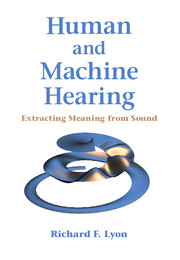Book contents
- Frontmatter
- Dedication
- Contents
- Foreword
- Preface
- Part I Sound Analysis and Representation Overview
- Part II Systems Theory for Hearing
- Part III The Auditory Periphery
- Part IV The Auditory Nervous System
- 20 Auditory Nerve and Cochlear Nucleus
- 21 The Auditory Image
- 22 Binaural Spatial Hearing
- 23 The Auditory Brain
- Part V Learning and Applications
- Bibliography
- Author Index
- Subject Index
- Plate section
23 - The Auditory Brain
from Part IV - The Auditory Nervous System
Published online by Cambridge University Press: 28 April 2017
- Frontmatter
- Dedication
- Contents
- Foreword
- Preface
- Part I Sound Analysis and Representation Overview
- Part II Systems Theory for Hearing
- Part III The Auditory Periphery
- Part IV The Auditory Nervous System
- 20 Auditory Nerve and Cochlear Nucleus
- 21 The Auditory Image
- 22 Binaural Spatial Hearing
- 23 The Auditory Brain
- Part V Learning and Applications
- Bibliography
- Author Index
- Subject Index
- Plate section
Summary
… how do we recognize what one person is saying when others are speaking at the same time (the “cocktail party problem”)? On what logical basis could one design a machine (“filter”) for carrying out such an operation? A few of the factors which give mental facility might be the following: (a) The voices come from different directions. (b) Lip-reading, gestures, and the like. (c) Different speaking voices, mean pitches, mean speeds, male and female, and so forth. (d) Accents differing. (e) Transition-probabilities (subject matter, voice dynamics, syntax …).
—“Some experiments on the recognition of speech, with one and with two ears,” Cherry (1953)… the majority of neurons in auditory thalamus and cortex coded well the presence of abstract entities in the sounds without containing much information about their spectro-temporal structure, suggesting that they are sensitive to abstract features in these sounds.
—“Auditory abstraction from spectro-temporal features to coding auditory entities,” Chechik and Nelken (2012)When the brain associates objects, abstract entities, or concepts with sounds, it is extracting meaning from sound. But the process cannot be as simple as a trainable classifier, because the brain must deal with input representing multiple such entities concurrently—the “cocktail party” problem. This, then, is the key function of the auditory brain: analyzing the auditory scene, to jointly decide what sound fragments to pay attention to and what those sound fragments represent. How this happens in the mammalian brain, and how we can model it in machines, remain key problems in the hearing field.
The structure of the auditory brain is complicated, being distributed across many levels and interwoven with somatosensory, visual, motor, and other parts. In this chapter, we survey together the structure and function of the auditory brain, focusing on the how meaning is extracted from complicated sound mixtures. The detailed functions, and their assignment to brain structures, remain rather speculative.
Scene Analysis: ASA and CASA
In his classic 1990 book Auditory Scene Analysis: The Perceptual Organization of Sound, Al Bregman (1990) explores a generalization of what he previously referred to as auditory stream segregation (Bregman and Campbell, 1971).
- Type
- Chapter
- Information
- Human and Machine HearingExtracting Meaning from Sound, pp. 400 - 416Publisher: Cambridge University PressPrint publication year: 2017



